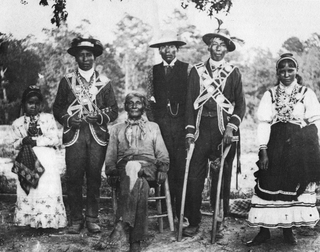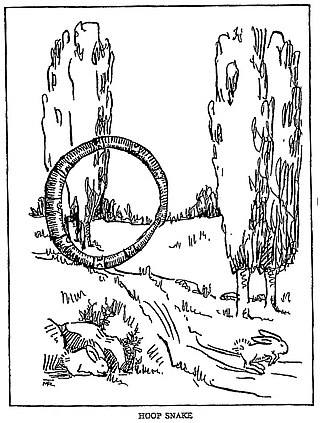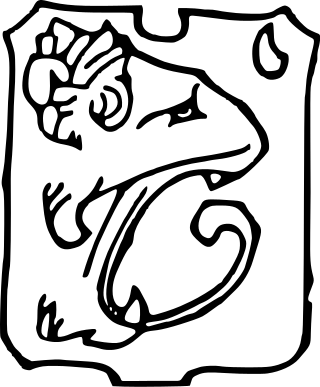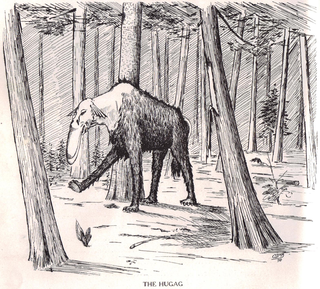American folklore encompasses the folklore that has evolved in the present-day United States mostly since the European colonization of the Americas. It also contains folklore that dates back to the Pre-Columbian era.

The thunderbird is a legendary creature particular to North American indigenous peoples' history and culture. It is considered a supernatural being of power and strength.

Choctaw mythology is part of the culture of the Choctaw, a Native American tribe originally occupying a large territory in the present-day Southeastern United States: much of the states of Mississippi, Alabama, and Louisiana. In the 19th century, the Choctaw were known to European Americans as one of the "Five Civilized Tribes" even though controversy surrounds their removal.

The Indigenous peoples of the Americas comprise numerous different cultures. Each has its own mythologies, many of which share certain themes across cultural boundaries. In North American mythologies, common themes include a close relation to nature and animals as well as belief in a Great Spirit that is conceived of in various ways.

The jackalope is a mythical animal of North American folklore described as a jackrabbit with antelope horns. The word jackalope is a portmanteau of jackrabbit and antelope. Many jackalope taxidermy mounts, including the original, are made with deer antlers.

In American folklore, the hodag is a fearsome critter resembling a large bull-horned carnivore with a row of thick curved spines down its back. The hodag was said to be born from the ashes of cremated oxen, as the incarnation of the accumulation of abuse the animals had suffered at the hands of their masters. The history of the hodag is strongly tied to Rhinelander, Wisconsin, where it was claimed to have been discovered. The hodag has figured prominently in early Paul Bunyan stories.

The hoop snake is a legendary creature of the United States, Canada, and Australia. It appears in the Pecos Bill stories; although his description of hoop snakes is the one with which people are most familiar, stories of the creature predate those fictional tales considerably. Several sightings of the hoop snake have been alleged along the Minnesota-Wisconsin border in the St. Croix River valley, Wake County in North Carolina, Prince Edward Island, and Kamloops, British Columbia.

Brazilian mythology is the subset of Brazilian folklore with cultural elements of diverse origin found in Brazil, comprising folk tales, traditions, characters and beliefs regarding places, people, and entities. The category was originally restricted to indigenous elements, but has been extended to include:

Fearsome Creatures of the Lumberwoods, With a Few Desert and Mountain Beasts is a 1910 fantasy field guide by William Thomas Cox (1878–1961), Minnesota’s first State Forester and Commissioner of Conservation, with illustrations by Coert du Bois and Latin classifications by George Bishop Sudworth The text is a noteworthy resource on folklore, as a century after its initial publication Fearsome Creatures remains one of the principal sources on legendary creatures of the United States and Canada.
The splintercat is a legendary fearsome critter in the folklore of the United States.

In North American folklore and American mythology fearsome critters were tall tale animals jokingly said to inhabit the wilderness in or around logging camps, especially in the Great Lakes region. Today, the term may also be applied to similar fabulous beasts.

In American folklore, the axehandle hound is a fearsome critter of Minnesota and Wisconsin.

The Hidebehind is a nocturnal fearsome critter from American folklore that preys upon humans that wander the woods, and was blamed for the disappearances of early loggers when they failed to return to camp. As its name suggests, the Hidebehind is said to be able to conceal itself. When an observer attempts to look directly at it, the creature quickly hides behind an object or behind the observer and therefore cannot be directly seen. The Hidebehind supposedly uses this ability to stalk human prey without being observed and to attack them without warning. Said victims, including lumberjacks and others who frequent the forests, are then dragged back to the creature's lair to be devoured. The creature subsists chiefly upon the intestines of its victim and has a severe aversion to alcohol, which is therefore considered a sufficient repellent. Tales of the hidebehind may have been used as an explanation of strange noises in the forest at night. Early accounts describe Hidebehinds as large, powerful animals, despite the fact that no one was able to see them.

The drop bear is a hoax in contemporary Australian folklore featuring a predatory, carnivorous version of the koala. This imaginary animal is commonly spoken about in tall tales designed to scare tourists. While koalas are typically docile herbivores, drop bears are described as unusually large and vicious marsupials that inhabit treetops and attack unsuspecting people that walk beneath them by dropping onto their heads from above.

A legendary creature is a type of fantasy entity, typically a hybrid, that has not been proven and that is described in folklore, but may be featured in historical accounts before modernity.

Canadian folklore is the traditional material that Canadians pass down from generation to generation, either as oral literature or "by custom or practice". It includes songs, legends, jokes, rhymes, proverbs, weather lore, superstitions, and practices such as traditional food-making and craft-making. The largest bodies of folklore in Canada belong to the aboriginal and French-Canadian cultures. English-Canadian folklore and the folklore of recent immigrant groups have added to the country's folk.
Maria Leach was an American writer and editor of books on folklores of the world. A noted scholar, she compiled and edited a major reference work on folklore and was the author or editor of thirteen books for adults, young people, and children.

The Goofus bird is a mythical, backwards-flying bird, originating in lumberjack folklore in North America. It is also known variously as the Filla-ma-loo bird or the Flu-fly bird.














